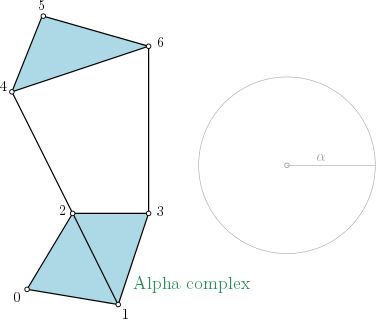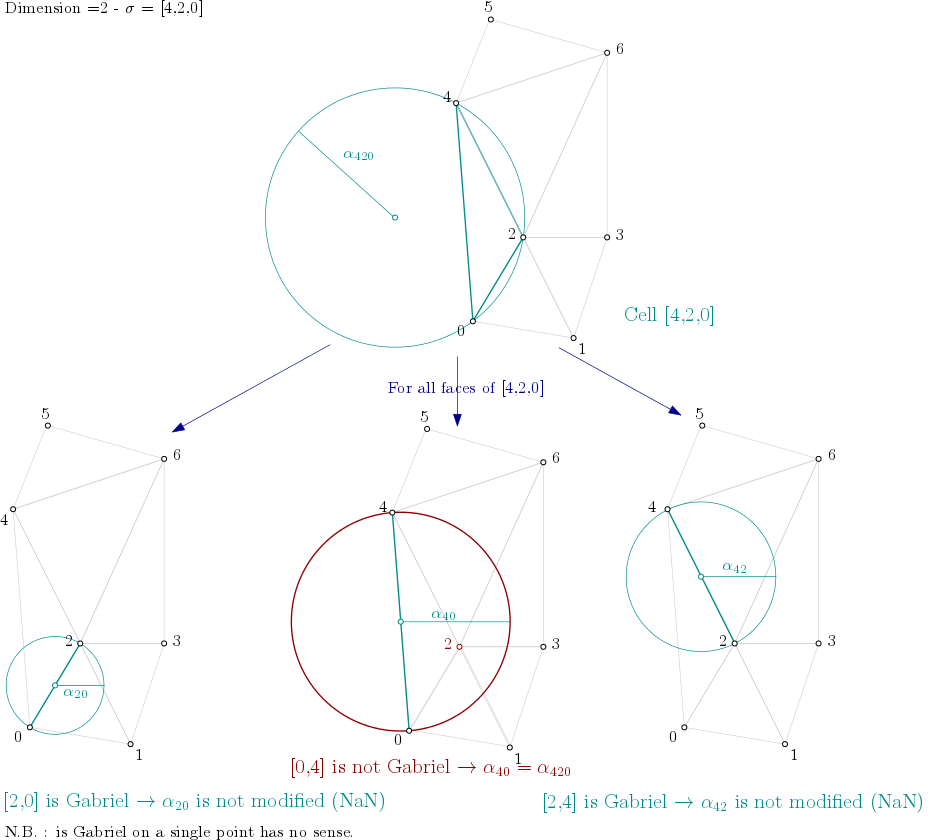Alpha complex user manual¶
Definition¶
|
|
|
||||||
|
Eigen3 |

Alpha complex representation |
Alpha_complex is a simplicial complex constructed from the finite cells of a Delaunay Triangulation. The filtration value of each simplex is computed as the square of the circumradius of the simplex if the circumsphere is empty (the simplex is then said to be Gabriel), and as the minimum of the filtration values of the codimension 1 cofaces that make it not Gabriel otherwise. All simplices that have a filtration value strictly greater than a given alpha squared value are not inserted into the complex. This package requires having CGAL version 4.7 or higher (4.8.1 is advised for better performance). |
| Alpha complex user manual | Alpha complex reference manual |
Alpha_complex is constructing a Simplex_tree using Delaunay Triangulation [1] from CGAL (the Computational Geometry Algorithms Library [2]).
Remarks¶
When Alpha_complex is constructed with an infinite value of \(\alpha\), the complex is a Delaunay complex.
Example from points¶
This example builds the Delaunay triangulation from the given points, and initializes the alpha complex with it:
import gudhi
alpha_complex = gudhi.AlphaComplex(points=[[1, 1], [7, 0], [4, 6], [9, 6], [0, 14], [2, 19], [9, 17]])
simplex_tree = alpha_complex.create_simplex_tree(max_alpha_square=60.0)
result_str = 'Alpha complex is of dimension ' + repr(simplex_tree.dimension()) + ' - ' + \
repr(simplex_tree.num_simplices()) + ' simplices - ' + \
repr(simplex_tree.num_vertices()) + ' vertices.'
print(result_str)
fmt = '%s -> %.2f'
for filtered_value in simplex_tree.get_filtration():
print(fmt % tuple(filtered_value))
The output is:
Alpha complex is of dimension 2 - 25 simplices - 7 vertices.
[0] -> 0.00
[1] -> 0.00
[2] -> 0.00
[3] -> 0.00
[4] -> 0.00
[5] -> 0.00
[6] -> 0.00
[2, 3] -> 6.25
[4, 5] -> 7.25
[0, 2] -> 8.50
[0, 1] -> 9.25
[1, 3] -> 10.00
[1, 2] -> 11.25
[1, 2, 3] -> 12.50
[0, 1, 2] -> 13.00
[5, 6] -> 13.25
[2, 4] -> 20.00
[4, 6] -> 22.74
[4, 5, 6] -> 22.74
[3, 6] -> 30.25
[2, 6] -> 36.50
[2, 3, 6] -> 36.50
[2, 4, 6] -> 37.24
[0, 4] -> 59.71
[0, 2, 4] -> 59.71
Algorithm¶
Data structure¶
In order to build the alpha complex, first, a Simplex tree is built from the cells of a Delaunay Triangulation. (The filtration value is set to NaN, which stands for unknown value):

Simplex tree structure construction example
Filtration value computation algorithm¶
- for i : dimension \(\rightarrow\) 0 do
- for all \(\sigma\) of dimension i
- if filtration(\(\sigma\)) is NaN then
- filtration(\(\sigma\)) = \(\alpha^2(\sigma)\)
end if
//propagate alpha filtration value
- for all \(\tau\) face of \(\sigma\)
- if filtration(\(\tau\)) is not NaN then
- filtration(\(\tau\)) = filtration(\(\sigma\))
end if
end for
end for
end for
make_filtration_non_decreasing()
prune_above_filtration()
Dimension 2¶
From the example above, it means the algorithm looks into each triangle ([0,1,2], [0,2,4], [1,2,3], …), computes the filtration value of the triangle, and then propagates the filtration value as described here:

Filtration value propagation example
Dimension 1¶
Then, the algorithm looks into each edge ([0,1], [0,2], [1,2], …), computes the filtration value of the edge (in this case, propagation will have no effect).
Dimension 0¶
Finally, the algorithm looks into each vertex ([0], [1], [2], [3], [4], [5] and [6]) and sets the filtration value (0 in case of a vertex - propagation will have no effect).
Non decreasing filtration values¶
As the squared radii computed by CGAL are an approximation, it might happen that these alpha squared values do not quite define a proper filtration (i.e. non-decreasing with respect to inclusion). We fix that up by calling Simplex_tree::make_filtration_non_decreasing() (cf. C++ version).
Prune above given filtration value¶
The simplex tree is pruned from the given maximum alpha squared value (cf. Simplex_tree::prune_above_filtration() in the C++ version). In the following example, the value is given by the user as argument of the program.
Example from OFF file¶
This example builds the Delaunay triangulation from the points given by an OFF file, and initializes the alpha complex with it.
Then, it is asked to display information about the alpha complex:
import gudhi
alpha_complex = gudhi.AlphaComplex(off_file=gudhi.__root_source_dir__ + \
'/data/points/alphacomplexdoc.off')
simplex_tree = alpha_complex.create_simplex_tree(max_alpha_square=59.0)
result_str = 'Alpha complex is of dimension ' + repr(simplex_tree.dimension()) + ' - ' + \
repr(simplex_tree.num_simplices()) + ' simplices - ' + \
repr(simplex_tree.num_vertices()) + ' vertices.'
print(result_str)
fmt = '%s -> %.2f'
for filtered_value in simplex_tree.get_filtration():
print(fmt % tuple(filtered_value))
the program output is:
Alpha complex is of dimension 2 - 23 simplices - 7 vertices.
[0] -> 0.00
[1] -> 0.00
[2] -> 0.00
[3] -> 0.00
[4] -> 0.00
[5] -> 0.00
[6] -> 0.00
[2, 3] -> 6.25
[4, 5] -> 7.25
[0, 2] -> 8.50
[0, 1] -> 9.25
[1, 3] -> 10.00
[1, 2] -> 11.25
[1, 2, 3] -> 12.50
[0, 1, 2] -> 13.00
[5, 6] -> 13.25
[2, 4] -> 20.00
[4, 6] -> 22.74
[4, 5, 6] -> 22.74
[3, 6] -> 30.25
[2, 6] -> 36.50
[2, 3, 6] -> 36.50
[2, 4, 6] -> 37.24
CGAL citations¶
| [1] | Samuel Hornus, Olivier Devillers, and Clément Jamin. dD triangulations. In CGAL User and Reference Manual. CGAL Editorial Board, 4.7 edition, 2015. URL: http://doc.cgal.org/4.7/Manual/packages.html#PkgTriangulationsSummary. |
| [2] | The CGAL Project. CGAL User and Reference Manual. CGAL Editorial Board, 4.7 edition, 2015. URL: http://doc.cgal.org/4.7/Manual/packages.html. |